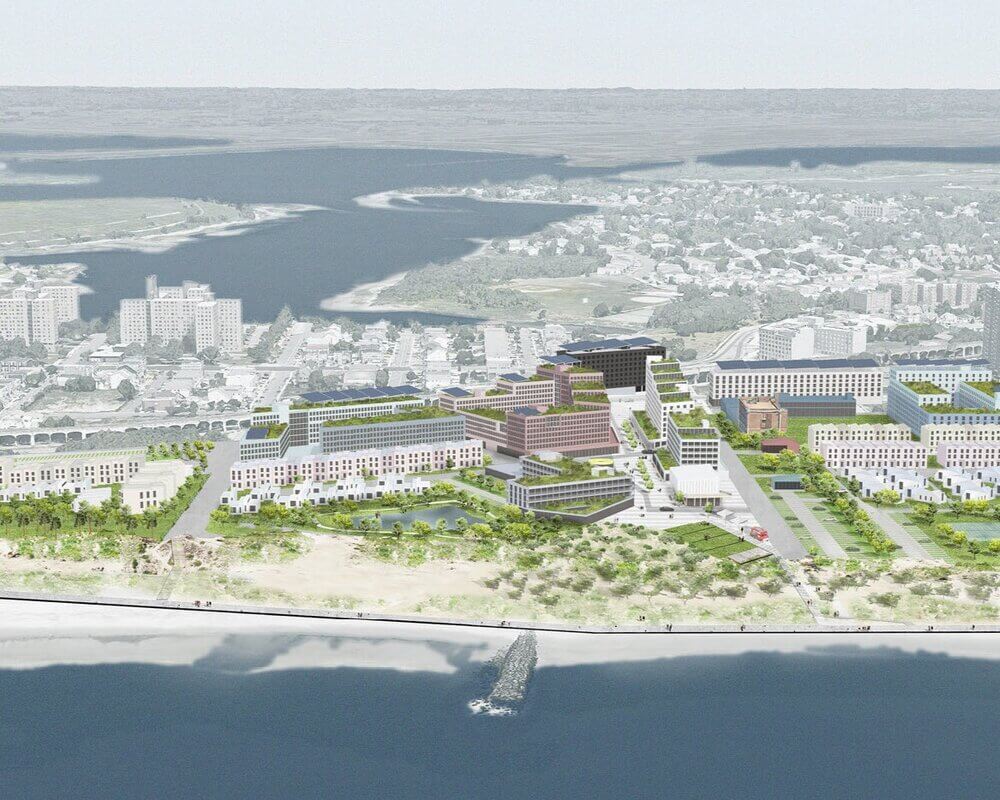Earlier this month, developers officially closed on a $31.3 million financial package to fund the construction of Arverne East, a master-planned community on a 116-acre site straddling the beachfront neighborhoods of Arverne and Edgemere in Queens, New York. The project, which will be the city’s first zero-carbon development, is jointly managed by a trifecta of full-service real estate firms: L+M Development Partners, the Bluestone Organization, and Triangle Equities.
Arverne East will be situated on what is currently vacant land between Beach 32nd Street and Beach 56th Place, occupying the entire area south of the elevated tracks of the A train. Formerly a popular coastal retreat for wealthy families from Manhattan and Brooklyn, parts of the Rockaway Peninsula nonetheless faced considerable disinvestment and abandonment in the 1970s and 1980s.
Private development increased significantly in the early 2000s as successive mayoral administrations pushed renewal schemes on the narrow strip of land. Still, the Rockaways are defined by social and physical juxtapositions. Much of the western part of the peninsula is occupied by pristine public beaches and higher-end gated communities with predominantly white residents, while the eastern portion is home to lower-income, predominantly African American and Hispanic immigrant communities.
With Arverne East, the development of new beachfront housing will creep further east into Edgemere, where the effects of Hurricane Sandy helped induce a shortage of grocery stores, hospitals, and other community facilities. The new complex will include 1,650 units of housing, 1,320 of which will be devoted to formerly homeless, low-income, and middle-income families at below-market rates. According to the development’s website, affordable homeownership schemes will also be available to residents hoping to acquire property on-site.
In addition to residential units, developers plan to include 180,000 square feet of commercial and office space, a restaurant and brewery operated by the Rockaway Brewing Company, a 60,000 square-foot hotel, and 22,000 square feet of community facilities on site. The aim of the commercial presence is to “promote year-round local businesses and jobs to serve local retail needs, as well as seasonal destination retail, further bolstering existing small business revenue generated by visitors.”

The new community center will be operated by the local nonprofit RISE, which serves various Rockaway communities with social resources, youth development programs, and initiatives to improve environmental conditions and resilience on the peninsula. RISE will also work closely with the city’s Department of Parks and Recreation to steward the project’s 35-acre nature preserve, which will be designed by landscape architecture firm Starr Whitehouse.
WXY will design the development’s 6,000 square-foot nature center, which will be equipped with geothermal technology and a photovoltaic array that generates more energy than the building consumes. As part of the first phase of Arverne East’s 10-year, multi-step construction process, the nature preserve will incorporate existing trees and additional native plant life in an approach that prioritizes access to the boardwalk and resilience to future flooding. Buildings in the complex will also be elevated three to eight feet off the ground plane, a preemptive move that exceeds requirements set out by the city government.
According to an announcement from the New York City Department of Housing Preservation and Development, which is providing partial funding to the development, Arverne East will feature a campus-wide geothermal loop, which “uses the earth’s ambient temperature as a source for heat transfer allowing for efficient heating and cooling.” Solar panels on the roofs of all buildings will enable the complex to offset its own energy consumption and achieve net-zero status.
While Arverne East has now garnered support from New York’s current mayor, the parks commissioner, and some of the neighborhood’s elected officials, the path to implementation was not entirely without its hiccups. According to The Rockaway Times, the project was initially rejected by members of Queens’ Community Board 14 on the grounds that it relied on an outdated Environmental Impact Statement (EIS) from 2003, before Hurricane Sandy further upended local resources and services.
By early 2021, though, the City Planning Commission denied that a new EIS was necessary and the project was approved by the City Council, with conditions from Rockaway representatives that the developers hire locally and maintain affordable housing commitments. The endorsement of Queens’ Borough President Donovan Richards, Jr. was particularly resounding: “The fact that Arverne East will include an innovative nature preserve and be the city’s first net-zero community makes this development truly transformational in every sense of the word.”











